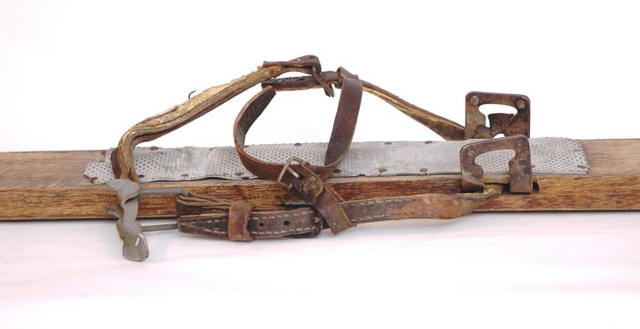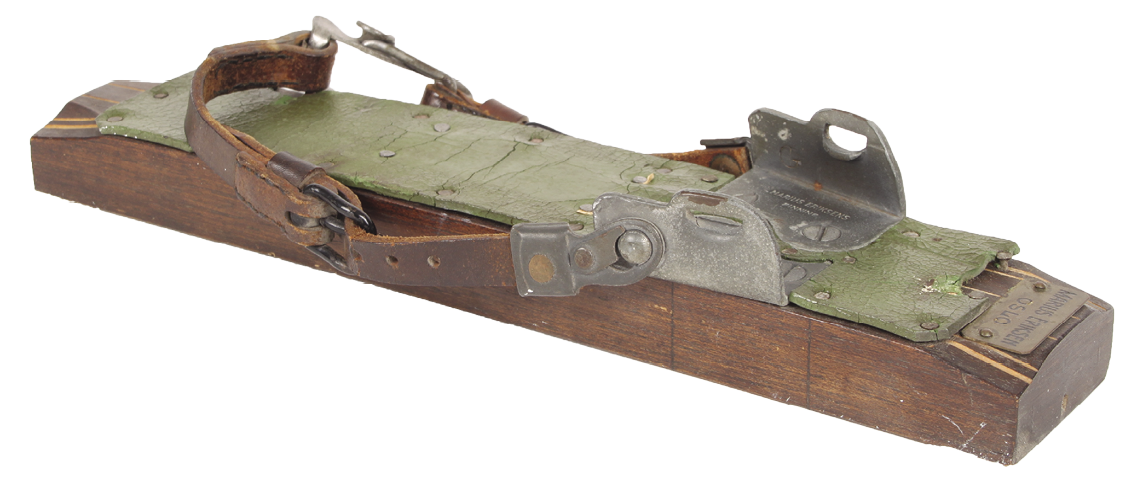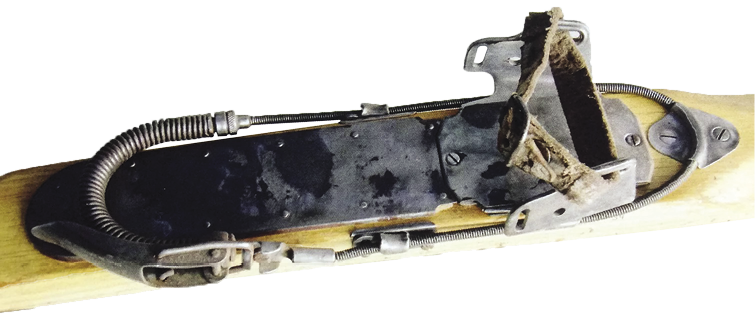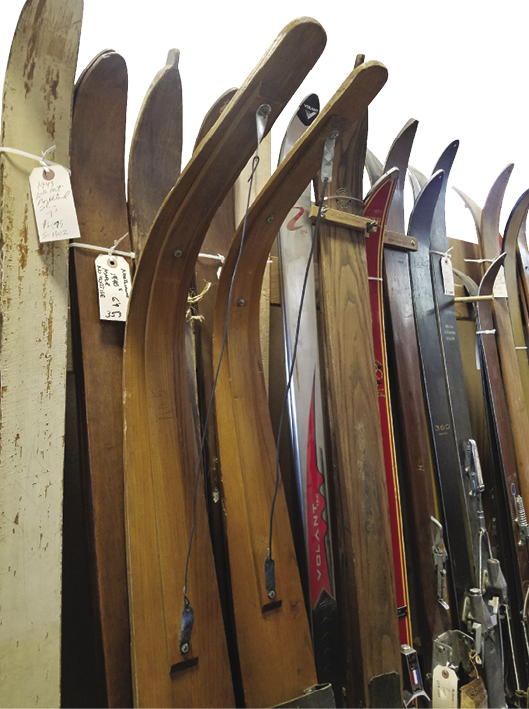SKIING HISTORY
Editor Seth Masia
Managing Editor Greg Ditrinco
Consulting Editor Cindy Hirschfeld
Art Director Edna Baker
Editorial Board
Seth Masia, Chairman
John Allen, Andy Bigford, John Caldwell, Jeremy Davis, Kirby Gilbert, Paul Hooge, Jeff Leich, Bob Soden
Founding Editors
Morten Lund, Glenn Parkinson
To preserve skiing history and to increase awareness of the sport’s heritage
ISHA Founder
Mason Beekley, 1927–2001
ISHA Board of Directors
Rick Moulton, Chairman
Seth Masia, President
Wini Jones, Vice President
Jeff Blumenfeld, Vice President
John McMurtry, Vice President
Bob Soden (Canada), Treasurer
Richard Allen, Skip Beitzel, Michael Calderone, Dick Cutler, Wendolyn Holland, Ken Hugessen (Canada), David Ingemie, Joe Jay Jalbert, Henri Rivers, Charles Sanders, Einar Sunde, Christof Thöny (Austria), Ivan Wagner (Switzerland)
Presidential Circle
Christin Cooper, Billy Kidd, Jean-Claude Killy, Bode Miller, Doug Pfeiffer, Penny Pitou, Nancy Greene Raine
Executive Director
Janet White
janet@skiinghistory.org
Membership Services
Jamie Coleman
(802) 375-1105
jamie@skiinghistory.org
Corporate Sponsorships
Peter Kirkpatrick
(541) 944-3095
peterk10950@gmail.com
Bimonthly journal and official publication of the International Skiing History Association (ISHA)
Partners: U.S. Ski and Snowboard Hall of Fame | Canadian Ski Museum and Hall of Fame
Alf Engen Ski Museum | North American Snowsports Journalists Association | Swiss Academic Ski Club
Skiing History (USPS No. 16-201, ISSN: 23293659) is published bimonthly by the International Skiing History Association, P.O. Box 1064, Manchester Center, VT 05255.
Periodicals postage paid at Manchester Center, VT and at additional mailing offices. Postmaster: Send address changes to ISHA, P.O. Box 1064, Manchester Center, VT 05255
ISHA is a 501(c)(3) public charity. EIN: 06-1347398
Written permission from the editor is required to reproduce, in any manner, the contents of Skiing History, either in full or in part.
Collectibles: Identifying and Dating Antique Skis
How old are these skis? Who made them, and where?
"How old are these skis?” We get this question via email several times a year, often from a non-skier who found a dusty pair of fossil planks in grandma’s attic. For all we know, the skis may have belonged to grandma’s grandma.
Photo above: Vintage Ski World stock includes homemade skis (foreground) and, left to right, 10th Mountain Division skis, round tips (1940s) and “sugar cube” tips (1930s).
Supplied with a few sharp photos, someone in the Skiing History community of experts can usually identify a ski, or at least assign a date of manufacture, within about five years’ leeway. Here’s what we look for:
Skis with wooden tops
Brand name. Is there a legible logo or stamped inscription? If so, look up the brand name at woodenskis.com. Webmaster Greg Fangel, a Skiing History editorial board member and occasional contributor to the magazine, provides thumbnail histories of most European, Scandinavian and North American factories that made wooden skis. Knowing when the factory was founded, and when it folded, provides a date range for your skis. If the ski is marked “Kristiania,” it was manufactured before 1925, when Norway’s capital city was renamed Oslo.
No brand name: If there’s no evidence of branding, the ski may be homemade, which usually dates it before about 1910. Between 1900 and 1920, manufactured skis became easily available by mail order and were cheap enough that only very dedicated skiers would spend the time to create something more specialized. Very long skis (more than nine feet) are certainly more than 100 years old and were probably carved by the skier himself (or by his pa). Handcarved skis were usually of local lumber—most often birch, pine or fir. These soft woods are light and easily worked. Fangel notes that early handmade skis are common but almost impossible to date. With the mining boom in Western states beginning around 1850, demand for skis was high and local carpenters filled the need. According to Richard Allen, ISHA board member and owner of VintageSkiWorld.com, there are important regional styles. For cross-country skis, Swedes and Finns made very narrow skis, typically less than 2.5 inches (65 mm) wide, while Norwegians and their North American descendants liked skis to be three or four inches wide (more than 70 mm).
Skis carved from a single plank (that is, not built up of laminations) usually had a nipple (you might call it a unicorn horn or a figurehead; old-timers call it a sugar cube). This served several purposes: It thickened the tip at a critical point to prevent the wood from splitting, it served as an attachment point when steaming the bend into the shovel or fixing a spreader to preserve the tip turn or for climbing skins, and, says Allen, trappers reportedly used the horn to kick at hostile carnivores. If there’s no horn, the end of the tip is probably carved thicker than the ski’s shovel to prevent splitting. “Ridgetop” skis are also typically carved from a single plank. The ridgetop was the only way a carpenter could make a ski torsionally forgiving without losing longitudinal stiffness and breaking strength. The top spine also helped the ski shed snow, notes Fangel.
Fangel uses this general classification: A ski with a flat top and scribed with decorative lines is from the 1920s; with a sugar cube, from the 1930s; with a round tip, from the 1940s. At Allen’s VintageSkiWorld website you’ll find a free appraisal service (vintageskiworld.com/vintage-ski-appraisals-s/200.htm). Fill in the form and attach photos, and Allen will identify the skis and estimate what they’re worth as antiques. (Disclaimer: Allen is an ISHA board member; this paragraph does not constitute an endorsement of his commercial
endeavors.)
Manufactured skis: Mass production of skis began in Scandinavia in the 1870s, when tungsten-steel hand tools from England first became widely available. By 1888, Norwegian immigrants had launched factories in Wisconsin and Minnesota. The factories became big business with the introduction of high-speed motorized sawblades around 1900. Manufactured skis came in four flavors: hickory, maple, ash and pine. Hickory, the choice for fast, powerful high-performance jumping and Alpine racing skis, is heavy and hard, and the wood selected for skis has a very straight grain pattern. Maple is nearly as hard and heavy as hickory. Ash was a bit lighter and whippier, and made for better slalom and cross-country skis. All three hardwoods materials were far more durable and expensive than pine, which was the lightest in weight.
Look at the bottom of the ski
If it has steel edges, it was made (or modified) after about 1928, and more likely after 1930 (the Lettner steel edge was patented in Austria in 1926). Most, but not all ski soles were finished with pine tar (a dark brown or black preparation) until the invention, in 1921, of slick, waterproof nitrocellulose lacquer. During the 1930s most factories waterproofed the wooden sole of the ski with nitrocellulose lacquer, often in a bright color. This stuff wore out, however, and skiers repainted their bases themselves with cans of store-bought lacquer.
Beginning around 1938, very expensive skis might have had a hard plastic base (of phenolic or Bakelite plastic). If the base is of celluloid (Cellulix or similar brand name), the date of manufacture is between 1945 and around 1959. If the base is polyethylene (a bit softer and waxier to the touch than Bakelite or Cellulix), the ski was made after 1954, and probably after 1957. Cheap skis continued to use lacquer bases into the 1950s.
Laminated skis, made from multiple layers, became commercially available with the adoption of waterproof casein glues after 1933.
Look at the top of the ski. Beginning around 1950, a few skis got plastic topskins in various colors. Makers of top-quality hickory skis often continued to use a clear varnish finish to show off the perfection of the wood grain, but plastic armor grew gradually more popular. Cheaper skis imitated the look with eye-catching paint jobs.
Look at the bindings

Holmenkollen Museum.
Often the best way to estimate a ski’s birthday is by the date of manufacture of the binding. Up to about 1890 nearly all skis were equipped with leather-strap bindings. Toe straps were either nailed or screwed to the ski, or passed through a horizontal hole (a mortise) drilled through from side to side. Metal parts began to appear with the introduction of the Huitfeldt “bolt” binding in 1894. Fritz Huitfeldt passed a bolt through the mortise and attached the toe straps to its ends. Soon he began using a flat iron bar (a “strap”) passed through the ski and turned up at the ends to form a toe iron, locating the boot toe laterally. The leather straps over the toe and around the heel were anchored to these iron “ears.” Skis with Huitfeldt-type bindings were made into the late 1920s. One advantage was that the relatively soft iron strap could be hammered into a shape that fit snugly to the skier’s boot.

Holmenkollen Museum
From 1913 on, skiers began to transition to toe irons stamped from harder steel and screwed solidly to the top of the ski. The Bergendahl-style binding, introduced in 1913, was made in two halves so it could be adjusted to the shape of the boot sole. In 1920, Marius Eriksen patented a toe iron with adjustable side plates, allowing readjustment if the skier changed boots. This became the pattern for all of the “beartrap” toe irons to follow.
A few surviving skis are equipped with the Zdarsky mechanical binding (patented 1896) or its derivative Bilgeri binding (1910). These stabilized the boot on a hinged steel plate, rather like some of the Alpine touring bindings of the 1970s and ’80s. They were manufactured in some quantity for the Austrian army during World War I.
1927 and ’28 were important years for bindings. The first year brought the introduction of the Rottefella, or pin binding. for cross-country skis. Rottefella means rat trap, which describes the appearance of the pivoting bail used to lock down the toe of the running shoe to engage a set of locating pins. Fangel points out that the original Rottefella bindings used six pins. In the late 1940s, they changed to four pins, and then three pins after 1960.

courtesy Swiss Ski Museum
In 1928, Guido and Henry Reuge introduced the Kandahar Alpine binding. It used an Eriksen-style toe iron and a spring-loaded cable around the boot heel; the cable hooked under a steel lug screwed to the sidewall of the ski to lock the heel down for Alpine racing. The Kandahar was widely imitated and became the standard rig for all Alpine skiing until well after European factories introduced “cable-less” heel bindings in 1966.
The first bindings designed to release in a fall reached the market just before World War II but became popular only after civilian skiing resumed after the war. Most release toes were used with Kandahar-style heel cables, but a few releasing heels, like the Cubco and Miller, went on sale before 1950. Dedicated releasing heel units (at the time often called “cable-less” heels) from European factories (Marker, Salomon, Look, Tyrolia, Geze, etc.) came into the market beginning in 1966.
The modern DIN adjustment system came into use in 1980. Bindings made before then have adjuster scales reading 1-2-3-4. Bindings for adults made from 1980 onward have scales that read 4-5-6-7-8 or 5-6-7-8-9-10.
A fairly reliable guide to age is patent filings. If you can identify the binding brand, there’s a good chance the U.S. Patent Office has the original drawings. See patents.google.com as a start. Patents are often filed under the name of the company founder rather than the brand (e.g., Jean Beyl for Look, Mitch Cubberley for Cubco or Hannes Marker for his eponymous company.)
Bear in mind that skiers often replaced old bindings with newer models. This means that skis can be many years older than their bindings; when that’s the case, you may see one or more sets of filled-in binding holes. 
Seth Masia is president of ISHA. He wrote “Skiers in Revolt” for the March-April issue of Skiing History.
Table of Contents
WORLD CHAMPIONSHIP ($3,000+)
BerkshireEast/Catamount Mountain Resorts
Gorsuch
Warren and Laurie Miller
Sport Obermeyer
Polartec
CHAMPIONSHIP ($2,000)
Fairbank Group: Bromley, Cranmore, Jiminy Peak
Hickory & Tweed
Rossignol
Snowsports Merchandising Corporation
WORLD CUP ($1,000)
Aspen Skiing Company
Atomic USA
Bogner of America
Boyne Resorts
Dale of Norway
Darn Tough Vermont
Dynastar/Lange/Look
Gordini USA Inc/Kombi LTD
Head Wintersports
Intuition Sports
Mammoth Mountain
Marker/Völkl USA
National Ski Areas Association
North Carolina Ski Areas Association
Outdoor Retailer
Ski Area Management
Ski Country Sports
Sports Specialists Ltd
Sugar Mountain Resort
Sun Valley Resort
Vintage Ski World
World Cup Supply
GOLD MEDAL ($700)
Larson's Ski & Sports
Race Place/Beast Tuning Tools
The Ski Company (Rochester NY)
Thule
SILVER MEDAL ($500)
Alta Ski Area
Boden Architecture PLLC
Dalbello Sports
Deer Valley
EcoSign Mountain Resort Planners
Elan
Fera International
Holiday Valley Resort
Hotronic USA/Wintersteiger
Kulkea
Leki
Masterfit Enterprises
McWhorter Driscoll LLC
Metropolitan New York Ski Council
Mt. Bachelor
New Jersey Ski & Snowboard Council
Nils
Russell Mace Vacation Homes
SchoellerTextil
Scott Sports
Seirus Innovations
SeniorsSkiing.com
Ski Utah
Snowbird Ski & Summer Resort
Steamboat Ski & Resort Corp
Sundance Mountain Resort
Swiss Academic Ski Club
Tecnica Group USA
Timberline Lodge and Ski Area
Trapp Family Lodge
Wendolyn Holland
Western Winter Sports Reps Association
World Pro Ski Tour


